Dargo (Symbol: Do)
EG208 | Profile No. 54 (Aldrick et al, 1992)
Geology
Palaeozoic granites, some coarse grained metamorphic sediments; deeply weathered.
Landform
Enclosed rolling low hills, with steep hills often adjoining stream lines. Elevation range 160 - 400 m with local relief 30 – 90 m, and typical slope gradients 8 – 20 %. Broad concave drainage lines with slope gradients generally less than 5 %.
The Dargo map unit may be subdivided into three components: moderate to gentle slopes are the most extensive component, generally without rock outcrops. Areas comprising open depressions and steep slopes generally with rock outcrop are less extensive.
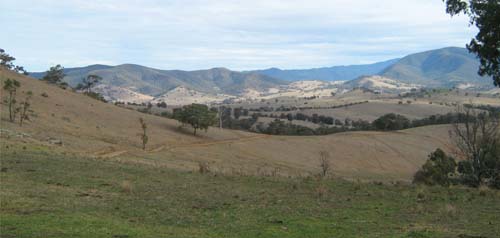
Enclosed rolling low hills and undulating footslopes, mostly cleared for grazing. The steep hills in the background
are mapped as the Talbotville map unit. The steep hill on the left is mapped as the Timbarra map unit.
Original vegetation
Grassy woodland.
Soils
| Component 1: Soils on moderate to gentle slopes Most of the soils on this map unit are texture contrast soils, which means they have light textured surface soils (generally sandy loams) abruptly overlying a clay subsoil. The surface soils are dark brown to reddish brown sandy loams abruptly overlying reddish brown to red clay subsoils at about 25 to 50 cm. They often have a bleached subsurface (typically pale brown) similar to the surface texture. Decomposing granite generally occurs between 0.7 and 1.2 m but may be deeper. Surface soils range in pH from strongly acidic to slightly acidic, have low to very low organic matter and a low water and nutrient holding capacity. The strongly structured subsoil clays are well drained with pH’s ranging from slightly acid to slightly alkaline. As they tend to slake considerably when wet, gully erosion may occur where water is channelled, for example along road reserves and in open depressions. Component 2: Soils in open depressions Deep gullies have formed in many of the open depressions. The exposed gully walls reveal a range of soils from very dark grey clays to yellow texture contrast soil. No soils were examined from this component. Component 3: Steep slopes Steep slopes, ranging from 20 – 50% or more, often adjoin the streams and major drainage lines. Rock is frequently exposed at the surface. No soils were examined on this unit. Land use The land is mostly cleared and used for grazing | 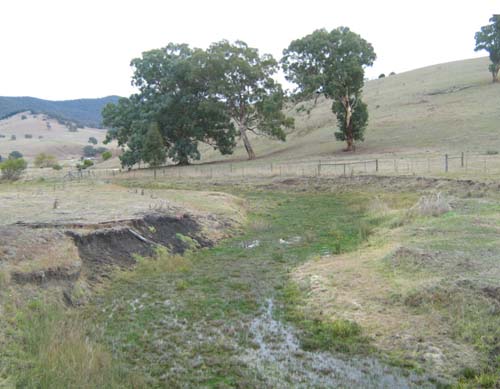 Dark grey clays in a drainage line near Dargo |
Site EG208
| Location: Dargo | Geo.Ref.: 518500E 5851700N |
| Australian Soil Classification: Bleached, Eutrophic, Brown CHROMOSOL | Bleached brown texture contrast soil |
| General landscape description: Rolling low hills | |
| Geology: Silurian granite (metamorphosed Ordovician sediments upslope) | |
| Site description: Simple mid slope – 8% facing north | |
| Land use: Grazing | |
| Original vegetation: Grassy woodland | |
| Map unit: Dargo (Component 1) |
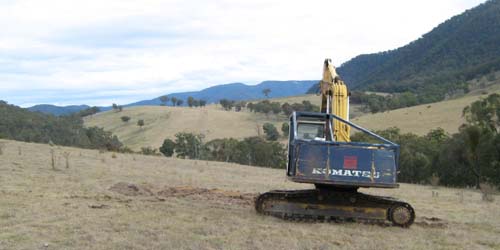
Rolling low hills of the Dargo map unit. The steep to very steep hills on the right are comprised of metamorphosed
Ordovician sediments and mapped as the Talbotville map unit. The excavator is back- filling the soil pit.
Soil Profile Morphology
Surface soil
| A1 | 0 – 10 cm | Dark brown (7.5YR3/2); sandy loam; moderate fine (2 – 5 mm) granular structure; weak consistence, moist; few (2 - 10 %) coarse angular pebbles (20 – 60 mm) derived from metamorphosed sediments upslope; clear change to: | 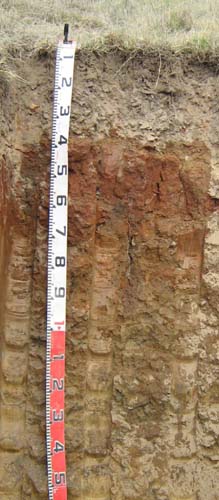 EG208 profile |
| A2 | 10 – 35 cm | Brown (7.5YR5/4), conspicuously bleached (7.5YR7/1d); sandy loam; apedal; weak consistence dry; abundant (50 – 90%) angular cobbles (60 -200 mm) derived from metamorphosed sediments upslope; sharp change to: | |
| Subsoil | |||
| B21 | 36 – 70 cm | Dark red (2.5YR3/6); medium heavy clay; strong coarse polyhedral structure; strong consistence dry; gradual change to: | |
| B22 | 70 – 120 cm | Dark yellowish brown (10YR5/4) mottled with yellowish red; medium clay; strong coarse polyhedral structure; strong consistence dry; diffuse change to: | |
| B23 | 120 – 180 cm | Dark yellowish brown (10YR5/4) mottled with yellowish red; medium clay, slightly sandy; moderate coarse lenticular structure; strong consistence dry. | |
- Sharp texture contrast between the surface soil (A horizons) and the subsoil (B horizons)
- Stone layer just above the clay subsoil.
Soil profile characteristics
| pH | Sodicity | Slaking | Dispersion Dry | Dispersion Remoulded | |
| Surface soil (A horizon) | Strongly acid | Non-sodic | Water stable | Nil (2 hours), Nil (20 hours) | Nil (2 hours), Nil (20 hours) |
| Subsurface soil (A2 horizon) | Moderately acid | Non-sodic | Partial | Slight (2 hours), Slight (20 hours) | Slight (2 hours), Moderate (20 hours) |
| Subsoil (B21 horizon) | Slightly alkaline | Non-sodic | Partial | Nil (2 hours), Nil (20 hours) | Strong (2 hours), Strong (20 hours) |
| Horizon | Depth cm | Texture | pH water | pH CaCl2 | EC dS/m | Coarse sand % | Fine sand % | Silt % | Clay % | Field cap. w/w | Wilt. point % w/w | PAW* water %w/w |
| A1 | 0-10 | SL | 5.1 | 4.4 | 0.06 | 20 | 53 | 11 | 10 | 21.9 | 8.6 | 13.3 |
| A2 | 10-35 | SL | 6.0 | 5.1 | <0.05 | 18 | 58 | 14 | 8 | 18.0 | 3.4 | 14.6 |
| B21 | 35-70 | MHC | 7.4 | 6.4 | 0.07 | 5 | 21 | 12 | 59 | 40.6 | 23.6 | 16.9 |
| B22 | 70-120 | MC | 8.2 | 7.2 | 0.08 | 11 | 34 | 16 | 35 | 34.1 | 17.6 | 16.5 |
| Depth | OrgC# | Total N | Free Fe2O3 | Exch. Al | Exchangeable cations cmol(+)/kg | Ca:Mg | ESP | ||||||
| cm | % | % | % w/w | ppm | Ca | Mg | K | Na | Total | H | CEC | ||
| 0-10 | 4.4 | 25 | 2.8 | 0.82 | 0.3 | 0.07 | 4 | 11 | 15 | 3.4 | <1 | ||
| 10-35 | 1.0 | <10 | 2.6 | 0.63 | 0.12 | 0.06 | 3.4 | 2.6 | 6 | 4.2 | 1 | ||
| 35-70 | 0.56 | 9 | 13 | 0.3 | 0.74 | 24 | 24 | 0.7 | 3 | ||||
| 70-120 | <0.30 | 9.6 | 15 | 0.25 | 1.2 | 26 | 26 | 0.6 | 3 | ||||
Management considerations
Whole profile
- Plant available water content for this profile is considered to be very low, estimated at 25 mm, as the effective rooting depth, considered here to be 40 cm, is largely limited by the dense and coarsely structured nature of the subsoil.
- The low wilting points (8.6 and 3.4 %) of the surface soils indicates the plants are able to utilize very light rains when the soil is dry. However, due to the low water storage capacity, plants will soon suffer moisture stress unless further rains occur.
- The surface soil is strongly acid. However the level of exchangeable aluminium is reasonably low (25 mg/kg) and is unlikely to affect the growth of aluminium sensitive species, except the most sensitive. Lime can be used to increase soil pH but a pH/aluminium test is best preformed by taking samples across the paddock and bulked together. The use of test strips to observe lime response should be used as an aid in evaluating its cost/benefit. For this soil a response to lime (about 1-2 tonnes/ha) would be expected.
- The organic matter content of the surface soil is high. Such levels result in a good surface structure and stability.
- Potassium is at a low level for pastures and a response to potassium fertilisers would be expected.
- The nutrient holding capacity of the surface (A1 and A2) horizons is very low (based on the sum of the exchangeable calcium, magnesium, potassium and sodium cations).
- Root and water movement is likely to be restricted in the dense and coarsely structured subsoil although the red colour of the subsoil indicates the soil is generally well drained.
- The roots tend to follow cracks between the soil aggregates and can only extract part of the soil water.
- The subsoil and the deep subsoil are slightly dispersive but slake considerably. If the subsoil is exposed, for example by a gully head, headward erosion is highly likely.
Profile No. 54 (Aldrick et al, 1992)
| Location: 2 km NE of Castleburn | Geo. Ref.: 517600E 5843200N |
| Australian Soil Classification: Melanic, Eutrophic, Red CHROMOSOL | |
| General landscape description: Rolling low hills | |
| Geology: Silurian granite | |
| Site description: 5% slope facing north-east on broad crest of spur | |
| Land use: Grazing | |
| Original vegetation: Grassy woodland | |
| Map unit: Dargo (Component 1) |
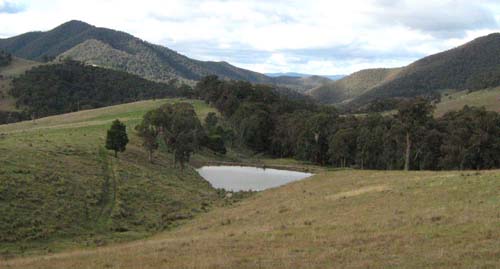
Rolling low hills of the Dargo Map unit near Castleburn. The steep hills in the background are mapped as Talbotville
Soil Profile Morphology
Surface soil
| A1 | 0 – 10 cm | Dark brown (10YR3/3); sandy loam; weak crumb structure; earthy fabric; soft when dry; diffuse change to: | 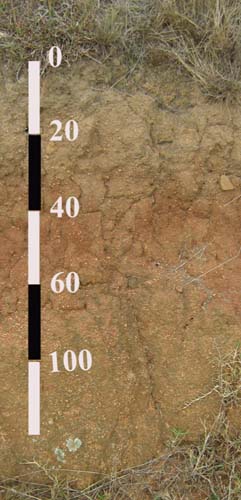 Photo of soil profile similar to the one described in this report |
| A2 | 10 – 25 cm | Brown (10YR4/3); sandy loam; apedal; hard when dry; porous; clear change to: | |
| Subsoil | |||
| B2 | 25 – 50 cm | Dark red (2.5YR3/6); sandy clay; weak fine angular blocky structure; smooth ped fabric; very firm when moist; common weathered feldspar and mica; clear change to: | |
| C | 50 – 120+ cm | Yellowish red (5YR5/6); sandy clay loam; apedal; firm when moist passing to weathering granite. | |
| Horizon | Depth cm | Texture | pH water | pH CaCl2 | EC dS/m | Coarse sand % | Fine sand % | Silt % | Clay % | Field cap. w/w | Wilt. point % w/w | PAW* water %w/w |
| A1 | 0-10 | SL | 6.1 | <0.05 | 43 | 36 | 13 | 7 | ||||
| A2 | 20-25 | SL | 6.2 | <0.05 | 37 | 32 | 17 | 13 | ||||
| B2 | 30-50 | SC | 6.6 | <0.05 | 31 | 25 | 15 | 29 | ||||
| C | 60-90 | SCL | 7.2 | <0.05 | 40 | 31 | 9 | 19 |
| Depth | OrgC# | Total N | Free Fe2O3 | Exch. Al | Exchangeable cations cmol(+)/k g | Ca:Mg | ESP | ||||||
| cm | % | % | % w/w | ppm | Ca | Mg | K | Na | Total | H | CEC | ||
| 0-10 | 1.8 | 0.15 | 1.0 | 4.2 | 0.8 | 0.4 | <0.1 | 5.4 | 10.7 | 5.3 | |||
| 20-25 | 0.19 | 0.03 | 1.9 | 3.6 | 1.7 | 0.2 | 0.2 | 5.8 | 9.4 | 2.1 | 2 | ||
| 30-50 | 3.3 | 7.5 | 3.3 | 0.3 | 0.5 | 11.6 | 16.8 | 2.3 | 3 | ||||
| 60-90 | 2.7 | 8.9 | 3.1 | 0.3 | 0.6 | 12.9 | 13.7 | 2.9 | 4 | ||||


